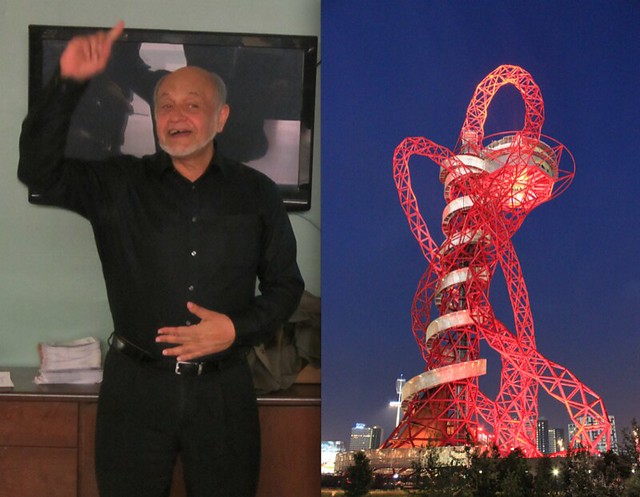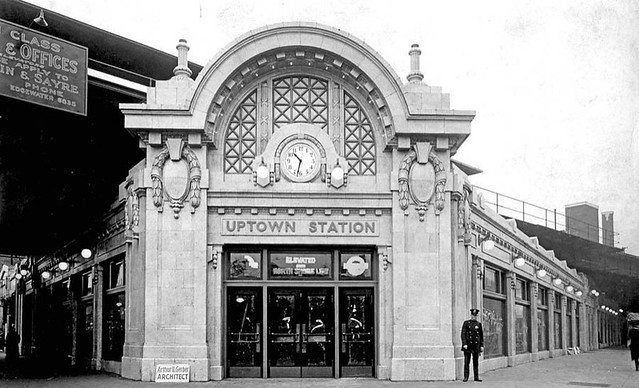[This piece also ran in Checkerboard City, John's transportation column in Newcity Magazine, which hits the streets on Wednesday evenings.]
“The essence of public sculpture is that, for a moment, it belongs to you,” says renowned Sri Lankan-British artist Cecil Balmond, speaking at a recent packed community meeting in the basement of an Uptown nursing home. Last July, the CTA hired Balmond to create artwork for the Wilson Red Line station, as part of a massive, $203 million reconstruction project. It’s notable that the Wilson stop—a notoriously grungy facility and three-time winner of RedEye’s “Crust Station” contest—will be getting a piece by a man whose website calls him “the world’s leading thinker on form and structure.”
Work to rebuild the station began last fall and, as of last month, crews were almost done using heavy equipment to demolish the westernmost set of tracks and concrete support pillars. In all, 2,200 feet of the one-hundred-year-old tracks will be replaced and relocated, and the station will be transformed into a new transfer point between the Red and Purple lines. As a result, you can expect an influx of Northwestern students and staff moving to Uptown by the end of the decade.
The project will also build a much roomier station house, with three entrances, wheelchair access, and plenty of sleek, modern surfaces, including a glassed-in main entrance on the south side of Wilson, with a twenty-foot-high ceiling. As a nod to the station’s history, its 1923 façade—whose stately beaux arts clock tower was amputated more than half a century ago—will be restored to its former glory.
Balmond’s installation will be joining the CTA’s collection of more than fifty artworks at forty-one stations. As part of the city’s ambitious slate of station upgrades, including many stops along the Red and Blue Lines, the transit agency is spending more than $3 million on new public art. The highest-profile of these pieces are two works by Chicago-based artist Theaster Gates, which will be installed as part of the Red Line’s $240 million 95th/Dan Ryan station overhaul.
Balmond was one of more than 200 people who submitted proposals for the Wilson stop. The total budget for the art project may not exceed $204,000, provided by the Federal Transit Administration. The artist’s fee can only make up ten percent of the cost, and $20,400 seems to be a rather modest fee for someone of Balmond’s stature. He says he decided to apply after seeing a vintage photo of the old station house, designed by noted transit architect Arthur Gerber.
Although some Uptown residents lobbied to have neighborhood-based artists create work for the station, the idea of recruiting a high-profile international artist surely appealed to CTA’s selection committee. Balmond is known for using computers to create abstract forms inspired by algorithms and fractals, as well as the mineral and plant kingdom structures that result from these mathematical phenomena.
His most famous work is the ArcelorMittal Orbit, a 376-foot-tall sculpture and observation tower created for the 2012 London Olympics in collaboration with Anish Kapoor, the artist who gave us Millennium Park’s Cloud Gate. The tower, which is the UK’s largest piece of public art, features serpentine red forms that encircle the main shaft in a seemingly random manner but, knowing Balmond, there’s plenty of science behind the design.
At the community input session, Balmond shows slides of many works he’s created in North America and Europe. There’s a monument to fallen heroes in Alaska, featuring stainless-steel rods suspended with acrylic light boxes. A tent-like shade sculpture he designed for an art center in Mesa, Arizona, is intended to serve as a community gathering place. His H_Edge installation, which has shown in several cities, features X-shaped aluminum plates suspended from chains in seemingly gravity-defying configurations.
My favorite is the Star of Caledonia, a huge thistle-like monument with illuminated spikes, which he recently designed to sit on the border between England and Scotland. The computer algorithm behind the sculpture is based on the concept of trips back and forth across the frontier. “As you walk into the sculpture, all those spikes will point at you,” Balmond says.
The artist has flown in for a short visit, and he spent the day touring the station and the other parts of Uptown with the architects and project managers. “My first impression is that the neighborhood has a lot of gaps and spaces, with big swings from poor and derelict areas to great 1930s architecture.”
Balmond adds that he was particularly impressed by the towering Bridgeview Bank building and the arabesque Aragon Ballroom. “Rest assured that I will come up with a design that will work with the neighborhood’s history,” he promises. The piece will be an abstract, three-dimensional work, located on the right as you enter the station’s atrium. “That will be a very dramatic space.”
The artist asks the crowd to share their “questions, ambitions and fears” about the piece. Residents encourage him to learn more about the community, including its immigration and civil rights history, and let that knowledge inform his piece. “This neighborhood has more nonprofits and social service agencies than anywhere else in the city,” notes one man. “This is an area with a lot of heart.”
At the end of the session, a CTA staffer notes that this is the largest attendance they’ve ever had for a community meeting on station artwork. “I don’t know if I was excited about transit and art before this,” says an attendee. “But I am now.”







